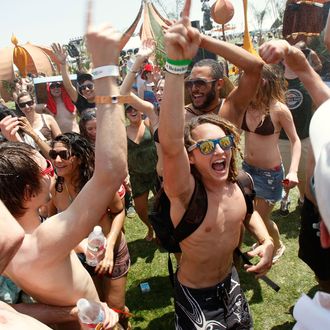
If your Instagram has been blowing up lately with selfies from Glastonbury, Panorama, or the zillion other music festivals happening across the world, you’ve got some contemporary evidence of the importance of partying. While it might be true that music festivals, concerts, and their kin are hotbeds of disease, the people who go to them are more satisfied with life. There are some ancient reasons why.
Evolutionary psychologists speculate that moving rhythmically together was a way for early humans to bond and communicate with one another. What contemporary Americans refer to as “partying” is of a piece with what French sociologist Émile Durkheim called “collective effervescence.” According to Durhkeim (and so many Snapchat stories), when people start moving in a shared, directed experience, a current of excitement starts pulsing through them. In his overview of Durkheim’s work, University of Montreal researcher Paul Carls writes that “This impersonal, extra-individual force, which is a core element of religion, transports the individuals into a new, ideal realm, lifts them up outside of themselves, and makes them feel as if they are in contact with an extraordinary energy,” one that leads to a “high degree of collective emotional excitement or delirium” for participants. To Durkheim, collective effervescence is part of how a religion takes wing, and it’s palpable in the prostrations of Muslim devotees, the chanting of Buddhist monks, or the shared “praise hands” of Christian Evangelicals. In secular society, the effervescence hasn’t been extinguished; it’s just been transmuted.
In a tribal or religious setting, University of Connecticut anthropologist Dimitris Xygalatas tells Science of Us, a shaman would have carried people through ecstatic experiences, but today that’s the role of the DJ (or rock band or soccer team, depending on your enthusiasm). Xygalatas has added empirical weight to collective effervescence. For a 2011 paper, Xygalatas and his colleagues went to a Greek village where fire-walking has been practiced for centuries. He rigged biomarker trackers to village people on the night of a fire-walking festival, where the emperor-saint Constantine is said to possess fire-walkers as they dance across hot coals. The ritual was “emotionally aligning” for the entire community, as indicated by heart rates. Viewers shared heart-rate synchrony with the fire-walkers, and the people who were socially closer with the fire-walkers — relatives and friends — had greater synchrony. That’s why, Xygalatas speculates, if you spend the weekend at a music festival, the acts that you identify with will sprinkle you with the fairy dust of collective effervescence while the ones that aren’t part of your identity might leave you disconnected, unsynchronized. For Xygalatas, a lifelong football fan, being at the stadium for his hometown team in Greece makes him feel electric, but he can go see a Barcelona match and observe the majesty of the team and traditions, but he won’t get goosebumps. “Ritual is a social technology,” he says. “There’s a communicative aspect, but also a primordial, instinctive aspect; to follow rhythm, be driven by it.”
From limited firsthand research, the secular sacrament of the rave seems to be particularly potent. (Maybe that’s why Berlin’s Berghain, the foremost techno club on Earth, is affectionately known to its regulars as “Church.”) Emma Cohen, an anthropologist who studies collective movement at Oxford, tells Science of Us that those warehouse parties you may trek out to in deep Bushwick provide a “sometimes addictive cocktail of pleasure and novelty” made with equal parts exercise, adventure, and body coordination and synchrony. “The exercise component is not so intense that, as with many sports, it feels like effort and pain — rather, dancing is typically at a manageable level of intensity that also happens to be a sweet spot for the release of exercise-induced endocannabinoids, the body’s own cannabis,” she writes in an email. “The synchrony and coordination enhance a sense of togetherness and bonding even among people who have never met.” At a festival or concert or dance party, you get a release from everyday routine and conventional expectations about behavior. To an outsider, she says, this is counterintuitive: The thump thump thump of electronic music may appear “mundanely repetitive,” but that misses the point. “Every night out can generate a good story,” she says, “maybe even the new love of your life!” After all, the music literally syncs people together.




